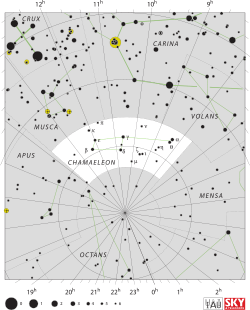Eta Chamaeleontis
Eta Chamaeleontis, Latinized from η Chamaeleontis, is a star in the constellation Chamaeleon. It has an apparent magnitude of about 5.5, meaning that it is just barely visible to the naked eye. Based upon parallax measurements made by the Hipparcos spacecraft, this star is located some 310 light years (95 parsecs) away from the Sun.[1]
 | |
| Observation data Epoch J2000 Equinox J2000 | |
|---|---|
| Constellation | Chamaeleon |
| Right ascension | 08h 41m 19.51346s[1] |
| Declination | −78° 57′ 48.0967″[1] |
| Apparent magnitude (V) | 5.453[2] |
| Characteristics | |
| Spectral type | B8V[3] |
| U−B color index | –0.34[4] |
| B−V color index | –0.10[4] |
| Astrometry | |
| Radial velocity (Rv) | 14.00[5] km/s |
| Proper motion (μ) | RA: -28.89[1] mas/yr Dec.: 27.21[1] mas/yr |
| Parallax (π) | 10.53 ± 0.16[1] mas |
| Distance | 310 ± 5 ly (95 ± 1 pc) |
| Absolute magnitude (MV) | +0.57[6] |
| Details | |
| Mass | 3.2[7] M☉ |
| Radius | 3.3[8] R☉ |
| Luminosity | 95[6] L☉ |
| Temperature | 12487 ± 98[9] K |
| Rotational velocity (v sin i) | 390[9] km/s |
| Other designations | |
| Database references | |
| SIMBAD | data |
Eta Chamaeleontis has a spectral type of B8V, meaning it is a B-type main sequence star.[3] These types of stars are a few times more massive than the Sun, and have effective temperatures of about 10,000 to 30,000 K. Eta Chamaeleontis is just over 3 times more massive than the Sun[7] and has a temperature of about 12,000 K.[9]
Eta Chamaeleontis cluster
Eta Chamaeleontis is the brightest and most massive member of the eponymous Eta Chamaeleontis cluster (also known as the Eta Chamaeleontis association or Mamajek 1, pronounced /ˈmæmədʒɛk/), a very nearby (316 light years), and young (8 million years old) stellar moving group discovered in 1999.[10] The cluster contains nearly 20 stellar members spread out over a 40-arcminute diameter region of sky, including the neighboring A-type star HD 75505 and the eclipsing binary RS Cha.[11] The eclipsing binary RS Cha is a well-constrained system which enables precise age-dating, which recent results yield an age of 9 million years.[12] All of the low-mass members (including RS Cha) are pre-main sequence, and several of them appear to still be accreting from protoplanetary disks. Although containing only about 20 members, the cluster appears to be the densest stellar cluster within 100 pc (~30 solar masses per cubic parsec)[13].
References
- van Leeuwen, F. (2007). "Validation of the new Hipparcos reduction". Astronomy and Astrophysics. 474 (2): 653–664. arXiv:0708.1752. Bibcode:2007A&A...474..653V. doi:10.1051/0004-6361:20078357.
- Høg, E.; et al. (2000). "The Tycho-2 catalogue of the 2.5 million brightest stars". Astronomy and Astrophysics. 355: L27–L30. Bibcode:2000A&A...355L..27H.
- "eta Del". SIMBAD. Centre de données astronomiques de Strasbourg. Retrieved 15 January 2016.
- Cousins, A. W. J.; Stoy, R. H. (1962). "Photoelectric magnitudes and colours of Southern stars". Royal Observatory Bulletin. Bibcode:1962RGOB...64..103C. (Accessed using SIMBAD)
- Kharchenko, N. V.; et al. (2007). "Astrophysical supplements to the ASCC-2.5: Ia. Radial velocities of ~55000 stars and mean radial velocities of 516 Galactic open clusters and associations". Astronomische Nachrichten. 328 (9): 889. arXiv:0705.0878. Bibcode:2007AN....328..889K. doi:10.1002/asna.200710776.
- Anderson, E.; Francis, Ch. (2012), "XHIP: An extended hipparcos compilation", Astronomy Letters, 38 (5): 331, arXiv:1108.4971, Bibcode:2012AstL...38..331A, doi:10.1134/S1063773712050015.
- Mamajek, Eric E.; Lawson, Warrick A.; Feigelson, Eric D. (1999). "The η Chamaeleontis Cluster: A Remarkable New Nearby Young Open Cluster". The Astrophysical Journal. 516 (2): L77–L80. Bibcode:1999ApJ...516L..77M. doi:10.1086/312005.
- Pasinetti Fracassini, L. E.; et al. (2001). "Catalogue of Apparent Diameters and Absolute Radii of Stars (CADARS) - Third edition - Comments and statistics". Astronomy & Astrophysics. 367: 521–24. arXiv:astro-ph/0012289. Bibcode:2001A&A...367..521P. doi:10.1051/0004-6361:20000451.
- Paunzen, E.; Schnell, A.; Maitzen, H. M. (2005). "An empirical temperature calibration for the Δ a photometric system . I. The B-type stars". Astronomy and Astrophysics. 444 (3): 941–946. arXiv:astro-ph/0509049. Bibcode:2005A&A...444..941P. doi:10.1051/0004-6361:20053546.
- "eta cha cluster". sim-basic. Retrieved 2020-06-12.
- Mamajek, E.E.; Lawson, W.A.; Feigelson, E.D. (1999). "The eta Chamaeleontis Cluster: A Remarkable New Nearby Young Open Cluster". Astrophysical Journal Letters. 516: L77. Bibcode:1999ApJ...516L..77M. doi:10.1086/312005.
- Alecian, E.; Lebreton, Y.; Goupil, M.-J.; Dupret, M.-A.; Catala, C. (2007). "Impact of the new solar abundances on the calibration of the PMS binary system RS Chamaeleontis". Astronomy & Astrophysics. 473 (1): 181–184. doi:10.1051/0004-6361:20077332.
- Mamajek, Eric (January 2016). "A Pre-Gaia Census of Nearby Stellar Groups". In J. H. Kastner; B. Stelzer; S. A. Metchev (eds.). Proceedings of the International Astronomical Union, Volume 10, Symposium S314 (Young Stars & Planets Near the Sun). 314. Atlanta, GA, USA. pp. 21–26. arXiv:1507.06697. Bibcode:2016IAUS..314...21M. doi:10.1017/S1743921315006250.
- General
- http://www.alcyone.de/cgi-bin/search.pl?object=HR3502
- http://server3.wikisky.org/starview?object_type=1&object_id=2968
- http://simbad.u-strasbg.fr/simbad/sim-basic?Ident=HR+3502&submit=SIMBAD+search
- "WEBDA open cluster database entry for Mamajek 1"